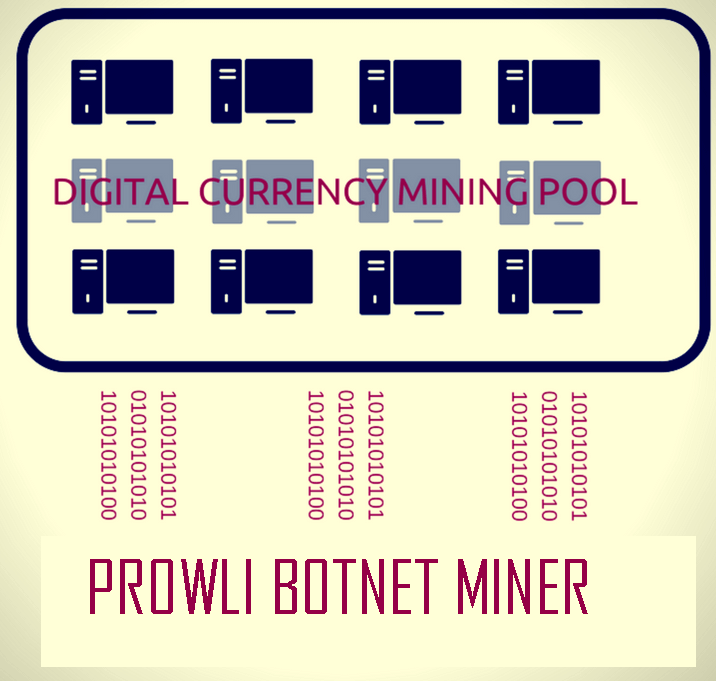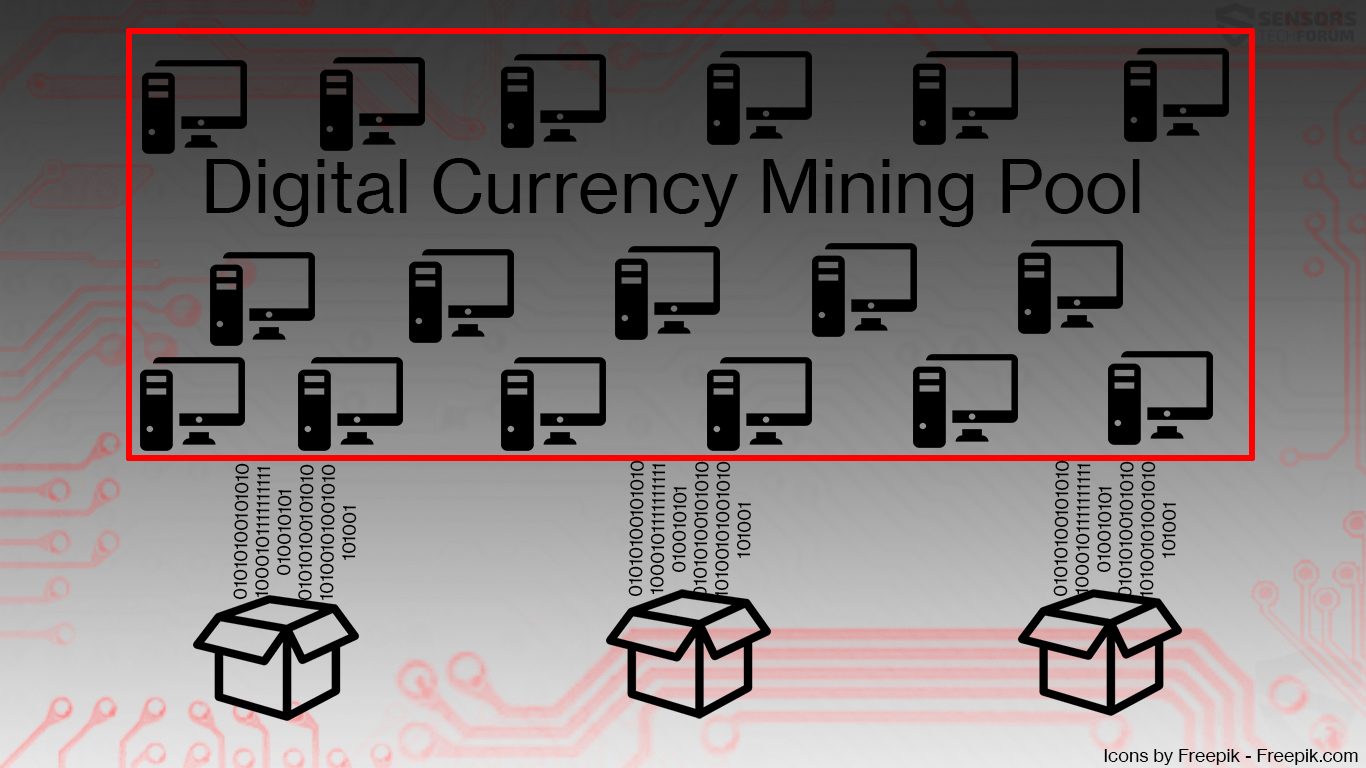 This article has been created in order to help you by explaining how to detect and remove the Prowli malware from your computer system and how to protect it against Prowli in the future.
This article has been created in order to help you by explaining how to detect and remove the Prowli malware from your computer system and how to protect it against Prowli in the future.
A new malware, going by the name Prowli has been detected by security researchers. The malware aims to attack websites and inject cryptocurrency mining script which results in using a vast amount of resources from the victim’s computer to mine for cryptocurrencies. The bad news here is that Prowly spreads from computer to computer and this botnet has now infected over 40 000 devices, which include servers, modems and even IoT devices to turn them into cryptocurrency miner slaves.

Threat Summary
| Name | Prowli Malware |
| Type | A botnet which is also a Trojan and a CryptoCurrency Miner virus. |
| Short Description | Infects via servers that are corrupted as a result of exploiting different vulnerabilties. |
| Symptoms | Your computer performs slow and may freeze at times. |
| Distribution Method | Bundled downloads. Web pages which may advertise it. |
| Detection Tool |
See If Your System Has Been Affected by malware
Download
Malware Removal Tool
|
User Experience | Join Our Forum to Discuss Prowli Malware. |

Prowli Malware – Distribution
The main methods via which this botnet is spread on users computers are believed to be via several exploits that are attacking WordPres and other sites on ready platforms, such as:
- CVE-2018-7482 (Joomla! With K2 extension).
- CVE-2014-2623 (HP Data Protector servers).
- Well-known exploits used in brute-force attacks.
- Drupal and PhpMyAdmin installations.
- NFS boxes.
- Servers with unsecured SMB ports (brute-forcing).
The Prowli hackers also use an SHH type of module which scans the SSH connection and aims to try and guess the username and password of devices which expose their SSH ports on the web. From there, the attackers may attack of the devices connected to those servers to also infect them, which is likely what follows.

Prowli Botnet Malware – Activity
As soon as the servers have been compromised, the Prowli malware gathers system information from the devices that are compromised, icluding IoT devices. Such information can be:
- Processing power.
- Internet connection and network details.
- Video Card power.
- RAM.
- Drive space.
These details about the devices are sent to the hackers who are also known as the Prowli Group. They start to filter out the devices they believe cannot be used for cryptocurrency mining operations. After the targeted devices are designated for infection, the hackers send a cryptocurrency miner which performs SSH-based attack and expands the botnet automatically to those devices.
The mining operation is done by connecting the victim device to a Monero mining pool that is linked to a cryptocurrency wallet (of the cyber-criminals). A cryptocurrency mining pool (displayed on the image below) is the type of network that connects different devices or group of devices in this case to a common mining operation.

The mining operation includes using the processing power of the devices to calculate complex calculations in order to complete sets of data, called blocks. These blocks are rewared to all of the wallets used in the mining process including to the one that is linked to the compromised devices, which results in more money for the cyber-criminals as more systems become compromised. This is a newer tendency within the cryptojacking world of cyber-crime and it feeds on the logic “the more computers and devices get infected, the more money are made”. This means that the botnet and its worm method of infecting devices much faster than how it would manually be results in the malware spreading at an immense rate and generating a lot of Monero tokens to the crooks. So far, the Prowli operation has resulted in over 40 thousand devices to be compromised, most of which are in South America, North America and Asia.

Remove Prowli Malware from Your Devices
In general Prowli, attacks Windows-based systems, meaning that the botnet is not different than any other malware. For the infection, it uses an r2r2 worm and to be effectively removed from servers takes some skills and time. So if you have an IoT device or a Server that is compromised by this worm, it is strongly reccomended that you backup all the data and call IT support so that they can make sure the whole network is safe, because if a Server is compromised, the r2r2 worm may automatically propagate to other devices.
If your personal computer or any other Windows device that is not a server has been infected with this worm, we do recommend to remove it by isolating the threat and then deleting it’s malicious files. Since this takes some skill to do, security researchers recommend doing it automatically by using an advanced anti-malware software. It is guaranteed to help you delete all of the malicious files of this virus and ensure future protection in the same time.
Preparation before removing Prowli Malware.
Before starting the actual removal process, we recommend that you do the following preparation steps.
- Make sure you have these instructions always open and in front of your eyes.
- Do a backup of all of your files, even if they could be damaged. You should back up your data with a cloud backup solution and insure your files against any type of loss, even from the most severe threats.
- Be patient as this could take a while.
- Scan for Malware
- Fix Registries
- Remove Virus Files
Step 1: Scan for Prowli Malware with SpyHunter Anti-Malware Tool



Step 2: Clean any registries, created by Prowli Malware on your computer.
The usually targeted registries of Windows machines are the following:
- HKEY_LOCAL_MACHINE\Software\Microsoft\Windows\CurrentVersion\Run
- HKEY_CURRENT_USER\Software\Microsoft\Windows\CurrentVersion\Run
- HKEY_LOCAL_MACHINE\Software\Microsoft\Windows\CurrentVersion\RunOnce
- HKEY_CURRENT_USER\Software\Microsoft\Windows\CurrentVersion\RunOnce
You can access them by opening the Windows registry editor and deleting any values, created by Prowli Malware there. This can happen by following the steps underneath:


 Tip: To find a virus-created value, you can right-click on it and click "Modify" to see which file it is set to run. If this is the virus file location, remove the value.
Tip: To find a virus-created value, you can right-click on it and click "Modify" to see which file it is set to run. If this is the virus file location, remove the value.Step 3: Find virus files created by Prowli Malware on your PC.
1.For Windows 8, 8.1 and 10.
For Newer Windows Operating Systems
1: On your keyboard press + R and write explorer.exe in the Run text box and then click on the Ok button.

2: Click on your PC from the quick access bar. This is usually an icon with a monitor and its name is either “My Computer”, “My PC” or “This PC” or whatever you have named it.

3: Navigate to the search box in the top-right of your PC's screen and type “fileextension:” and after which type the file extension. If you are looking for malicious executables, an example may be "fileextension:exe". After doing that, leave a space and type the file name you believe the malware has created. Here is how it may appear if your file has been found:

N.B. We recommend to wait for the green loading bar in the navigation box to fill up in case the PC is looking for the file and hasn't found it yet.
2.For Windows XP, Vista, and 7.
For Older Windows Operating Systems
In older Windows OS's the conventional approach should be the effective one:
1: Click on the Start Menu icon (usually on your bottom-left) and then choose the Search preference.

2: After the search window appears, choose More Advanced Options from the search assistant box. Another way is by clicking on All Files and Folders.

3: After that type the name of the file you are looking for and click on the Search button. This might take some time after which results will appear. If you have found the malicious file, you may copy or open its location by right-clicking on it.
Now you should be able to discover any file on Windows as long as it is on your hard drive and is not concealed via special software.
Prowli Malware FAQ
What Does Prowli Malware Trojan Do?
The Prowli Malware Trojan is a malicious computer program designed to disrupt, damage, or gain unauthorized access to a computer system. It can be used to steal sensitive data, gain control over a system, or launch other malicious activities.
Can Trojans Steal Passwords?
Yes, Trojans, like Prowli Malware, can steal passwords. These malicious programs are designed to gain access to a user's computer, spy on victims and steal sensitive information such as banking details and passwords.
Can Prowli Malware Trojan Hide Itself?
Yes, it can. A Trojan can use various techniques to mask itself, including rootkits, encryption, and obfuscation, to hide from security scanners and evade detection.
Can a Trojan be Removed by Factory Reset?
Yes, a Trojan can be removed by factory resetting your device. This is because it will restore the device to its original state, eliminating any malicious software that may have been installed. Bear in mind that there are more sophisticated Trojans that leave backdoors and reinfect even after a factory reset.
Can Prowli Malware Trojan Infect WiFi?
Yes, it is possible for a Trojan to infect WiFi networks. When a user connects to the infected network, the Trojan can spread to other connected devices and can access sensitive information on the network.
Can Trojans Be Deleted?
Yes, Trojans can be deleted. This is typically done by running a powerful anti-virus or anti-malware program that is designed to detect and remove malicious files. In some cases, manual deletion of the Trojan may also be necessary.
Can Trojans Steal Files?
Yes, Trojans can steal files if they are installed on a computer. This is done by allowing the malware author or user to gain access to the computer and then steal the files stored on it.
Which Anti-Malware Can Remove Trojans?
Anti-malware programs such as SpyHunter are capable of scanning for and removing Trojans from your computer. It is important to keep your anti-malware up to date and regularly scan your system for any malicious software.
Can Trojans Infect USB?
Yes, Trojans can infect USB devices. USB Trojans typically spread through malicious files downloaded from the internet or shared via email, allowing the hacker to gain access to a user's confidential data.
About the Prowli Malware Research
The content we publish on SensorsTechForum.com, this Prowli Malware how-to removal guide included, is the outcome of extensive research, hard work and our team’s devotion to help you remove the specific trojan problem.
How did we conduct the research on Prowli Malware?
Please note that our research is based on an independent investigation. We are in contact with independent security researchers, thanks to which we receive daily updates on the latest malware definitions, including the various types of trojans (backdoor, downloader, infostealer, ransom, etc.)
Furthermore, the research behind the Prowli Malware threat is backed with VirusTotal.
To better understand the threat posed by trojans, please refer to the following articles which provide knowledgeable details.


